 Accommodation | International
Flights | Domestic
Flights | Tours
| Travel
Insurance | Car
Hire | Visas
| Shopping
| Dating
| Humour
Accommodation | International
Flights | Domestic
Flights | Tours
| Travel
Insurance | Car
Hire | Visas
| Shopping
| Dating
| Humour Australian Aborigines
Aborigines are thought to have entered Australia from South East Asia at least 40 000 years ago when ice-ages had lowered sea levels to the point where it was possible to walk across between Asia, New Guinea, Australia and Tasmania.
At the time of James Cook's arrival they were estimated to number between half a million to three million, nowadays there are about 460 000 left, which is only about 2.4% of Australia's current population, this includes Torres Strait Islanders.
Reasons for their decline are disease introduced by settlers, the loss of traditional lands and food supplies, being shot by settlers (especially in Tasmania where Aborigines have been hunted to extinction), and generally not being taken care of by authorities for whom they officially did not exist.
They were not counted in the census, could not vote and had no citizens rights until 1967 when the government held a referendum in which Australians voted in an overwhelming majority to grant them the same rights as all other Australians.
Nowadays they have landrights and own more than a third of the Northern Territory, including all the major tourist icons like Kakadu, Katherine Gorge and Ayres Rock, and many other parts of Australia.
Aborigines and National Parks manage the parks together, creating some meaningful employment in remote areas where jobs are hard to come by.

The Aboriginal flag
The Aboriginals are divided into many tribes and
clans with many different dialects and languages.
They are very spiritual people and have a complex system involving
sacred sites and some of the knowledge passed on from generation
to generation is "classified" as secret mans or womans
business. Their laws and justice system are partly recognized by
the Australian justice system and in certain cases Aborigines have
been allowed to punish offenders with "payback" (which
often involves bashing with lumps of wood and spears in the legs)
instead of them being sent to jail. (Otherwise they'd be punished
twice as after being released from jail they would still receive
their payback).
They also believe that certain Aborigines have the power to kill
by simply "pointing the bone" at somebody. One Aboriginal
woman travelled to Canberra and pointed the bone at Prime Minister
John Howard but several years later
he was still cruising around ( much to the disappointment of some
people.).
Aboriginal trackers are famous for their amazing tracking skills
and are often called on in outback searches for missing people.
They have an extensive knowledge of bush survival skills being able
to find water and food in the most unlikely barren places and obtaining
medicinal plants from the bush.
Their most famous contributions to today's world from a tourist's
perspective are the didgeridoo and boomerang that make very popular
souvenirs.
Their culture is difficult to discover and experience for the tourists as not many Aborigines live a truly traditional lifestyle nowadays and they would be in very remote places, often in reserves requiring permits. The Aborigines you see in the city are often not the best examples, some have chosen to live there but others might only be there because they broke traditional laws and were banished from their community, but their culture is now on display in various cultural centres, dance theatres and on tours around Australia where tourists can learn about their traditional music, bushtucker, rituals, sacred sites and dances.
In March 2005 Prince Charles toured the Alice Springs Desert Park and Arrernte women had dug up some witchetty grubs for him and collected sweet honey ants but palace staff told them not to give Charles any bush tucker to sample unless he asked for it.
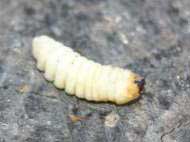
Witchetty grub
Aboriginal people from different parts of Australia
have their own names for themselves such as Koori, Yamaji, Nunga,
Murri etc; these names are specific to various regions. On your
travels, another word for Aborigine you may come across is 'blackfella',
some Aborigines refer to people as blackfellas and whitefellas,
while they often use these terms it is not always appreciated if
white people use them.
Another name you may come across is 'Abo', This word is NOT politically
correct, you should not use it but at least now you know what it
means in case you hear it. In a country full of ambos, avos, garbos,
milkos, lilos, journos, biros, musos, servos, salvos, regos, thingos
and preggo sheilas, it is a somewhat understandable abbreviation
but be aware that it can be an offensive word and we do not encourage
its use.
If you find yourself in the company of rednecks you may also hear
the words 'coon' or 'boong', these are very derogatory terms, even
worse than calling an Afro-American a nigger, and you should definitely
not use them, but at least now you know what they mean now in case
you hear them around you, and you can move on to find better company.
Some tours to learn about Aboriginal culture;
Around Uluru

Kata Tjuta
© Northern Territory Tourist Commission
Want to experience sacred sites known to the Aboriginal people, then dine under the stars of the Outback? This is a fantastic opportunity to explore unforgettable landscapes and feel the enchantment of the wilderness for yourself. Sit at your private dining setting in the middle of the desert and dine in the serenity of the Outback under a million stars, more info on this tour...
|
|||||
Northern Territory, from Darwin
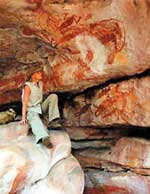
Aboriginal Rock Art
© Discovery Ecotours
Arnhem Land is a huge Aboriginal reserve, and normally
difficult to access as entry permits are required, and they are
not given to just anyone. This 2 day up-market camping safari takes
the worry out of things for you and combines some of the best of
Kakadu National Park with the special experience of traveling in
Aboriginal Arnhem Land.
The highlights of the trip include pristine World Heritage wetlands,
wilderness teeming with wildlife and unparalleled Rock Art away
from the more popular sites. Travel in comfortable 4WD vehicles,
dine on superb fresh food by candlelight, complemented by good Australian
wine, either under the stars or in the rustic restaurant of Davidson's
exclusive safari camp near Mount Borradaile in Arnhem Land ,
more info on this tour....
A shorter tour that does it all in one (long) day is also available; View Aboriginal rock art at the famous Ubirr artsite that is thousands of years old. Cruise the East Alligator River and by special permission, take a short walk into Arnhem Land. More info on this tour....
Queensland, Cairns / Port Douglas
Queensland, Gold Coast
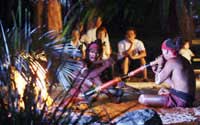
Listen to the sounds of the Didgeridoo
© Currumbin Wildlife Sanctuary
Seventy-five per cent of Australia'a wildlife is nocturnal, so when the sun goes down, the bush comes to life. The Wildnight Tour is a unique chance to see these amazing animals up close on a specially guided tour conducted by Currumbin Wildlife Sanctuary's wildlife experts. There's also a chance to journey into the Dreamtime and experience a traditional Aboriginal corroboree. More info on this tour....
Western Australia, the north west
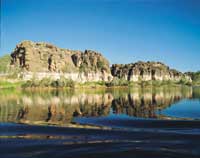
Geikie Gorge
© WA Tourism Commission
Considered one of the great marvels of the Kimberley, Geikie Gorge has long been one of the most visited icons of the region. This journey is brought to life with a memorable Aboriginal cultural tour that will leave you with a great respect for the people and the prehistoric geology surrounding this treasured gorge. More info on this tour....
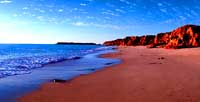
Cape Leveque
© Australian Pinnacle Tours
Experience a 4WD adventure to the remote wilderness area of Cape Leveque. Visit the Beagle Bay and Lombadina Aboriginal communities to met the locals and perhaps purchase their arts and crafts. The days highlight is the unspoilt beach haven of Cape Leveque, where you have free time to swim, relax and explore its tranquil beauty.
You can also combine this tour with a flight to appreciate the ruggedness of this landscape from the air, more info...
Some of Australia's better known Aborigines;
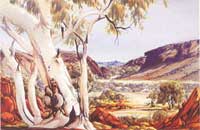
Heavitree Gap, Alice Springs, by Alfred Namatjira
Buy at Picturestore.com.au
This section still needs some additions, if you feel inspired to write some for us please contact us...
Aden Ridgeway -
Albert Namatjira - the first Australian Aborigine to be recognized both nationally and internationally as an artist. He is now one of Australia's best-known artists. His landscape paintings capture the essence of the Australian outback. Albert Namatjira was born in the Arrernte tribe near Alice Springs in 1902 and died in 1959, he was awarded a Queen Elizabeth II Coronation Medal in 1953. Some of his children also became succesful water color artists.
Bennelong - As a member of the Eora tribe that lived around Sydney harbour he was instrumental in the first contacts between European and Aboriginal people. He was one of the Aborigines captured in 1789 when Governor Philip thought it was time to learn more about them. Bennelong was treated well but still did not enjoy his imprisonment and disappeared half a year later. He turned up again after an incident where Philip had been speared and Bennelong said he had punished the offender. After this meeting the friendship between Bennelong's tribe and the settlers improved, and Philip even had a hut built for him. In 1792 Bennelong sailed to England with Philip and met with the king and many other nobles. He returned to Australia three years later and died in 1983.
Cathy Freeman - She was born in a
fast family, her grandfather was a runner, her father was a runner
and so she became a runner too. At the age of 16 she left home to
move to the Gold Coast where she received training from a professional
coach on a scholarship. She became the first Aboriginal woman to
compete in the Commonwealth Games where she won a gold medal and
became Australian of the Year. In the following years she continued
to win numerous gold medals at Olympic and Commonwealth Games around
the world.
Other awards included the Order of Australia Medal and in 2000 she
was chosen to light the cauldron at the Sydney Olympics.
Charles Perkins -
David Gulpilil - well known actor who started his career with the 1971 film Walkabout.
David Unaipon -
Eddie Mabo - A Torres Strait Islander
who became famous in in the 1980s with his landclaim that took ten
years to settle, and he sadly died before he could hear the good
news that he had won.
He was born on Mer Murray Island in the Torres Strait and together
with some others lodged a land claim to win native title. The Queensland
government tried to stop them from claiming title but the High Court
of Australia ruled in the islanders' favour and decided that the
'terra nullus' (uninhabited land) theory of Australia at the time
of James Cook's arrival was invalid and that indigenous people still
owned the land as they had done before.
Ernie Dingo - forever exploring exotic locations in the Australian holiday TV show Getaway.
Geoff Clarke - not looking all that black, he was chairman of ATSIC (Aboriginal and Torres Strait Islander Commission) for some time but was suspended for various things like being involved in a pub brawl and rape allegations, tried very hard to get his job back but John Howard abolished ATSIC and that was the end of that.
Jack Davis - Famous writer who was born and raised in Western Australia. Since the 1930s he has written several books of poems, four plays, and worked as the managing director of the Aboriginal Publications Foundation. Through his writing he was able to make the world aware of the plight of Aborigines, and he received an impressive number of awards, such as Aboriginal writer of the year in 1981, an honorary doctorate in literature and an order of Australia medal in 1985.
Lowitja O'Donoghue -
Mandawuy Yunupingu -
Noel Pearson -
Oodgeroo Noonucal -
Pat O'Shane -
Reginald Saunders -
Yothu Yindi - a Northern Territory band that had a world hit with their song Treaty.
Wandjuk Marika -
William Barak - When Aboriginal people were driven from their land around Melbourne in the 1830s they were moved to missions and reserves, and then moved again and again as white settlers needed more grazing land for their animals. William Barak rose as their leader and managed to convince the Victorian government to allow the Woiurrong people to stay on Coranderkerk Reserve.
William Cooper - A member of the
Yorta-Yorta from Victoria who rose to be a political leader that
demanded that Aborigines be treated equally to other Australians.
He started his campaign of petitions and letters in 1933 and founded
the Australian Aborigines League in 1936. When the settlers celebrated
the colony being 150 years old he organized a Day Of Mourning to
make everyone aware of what this 150 years had meant to Aborigines.
He wanted full citizenship rights for his people and introduced
'Aborignes Day' , the first one was held on 28 January 1939.
Windradyne -
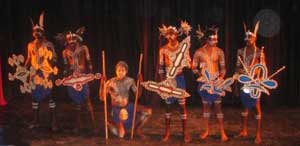
One of the Aboriginal dance shows you will find in Australia
The Pintupi nine - "The Lost Tribe"
In October 1984 Melbourne newspaper 'The Herald' ran
a spectacular headline "We find the lost tribe! " A group
of nine Aborigines was discovered in the forbidding Great Sandy
Desert who still walked around naked and had never seen a car or
shotgun before! They were in fact not lost at all but just living
a nomadic lifestyle and surviving just fine. But their "discovery"
was considered huge news in an age like 1984 where people considered
the world fully explored and charted.
During the 1950's the British were firing rockets from Woomera direction
west and thought it was best to move the local Pintupi tribe Aborigines
out of the area so they relocated them up to the Northern Territory
and north west Western Australia. They did not fare well there and
alcohol did its damage.
But during the 1970s when Aborigines were given landrights they
started making plans to return to their home lands and in 1981 the
Pintupi traveled to Kintore near the Western Australia border to
set up a community. Later they crossed the border as their actual
homeland lay further west and so it happened that in 1984 when Pinta
Pinta and his family were setting up a settlement at Winparrku that
they were spotted by Piyiti and Warlimpirrnga, who were scared by
their car, intrigued by their clothes, and angry about them invading
their land.
They met but initially did not know they all originated from the
same tribe and there was a tense stand-off where they were frightened
of eachother and a gunshot was fired. This caused the settlers to
flee and, on a flat tyre, they drove 60 km. back to the others to
tell them what they had seen, still thinking they had seen ghosts
or scorcerers.
Fortunately Freddy West Tjakamarra knew of a family that had never
come in to let themselves be transported by the British and they
felt sorry for 'the naked ones' as they called them and decided
to look for them.
It took them some time as the two had gone on the run north, having
been vary scared by the shotgun, and they tried to hide their tracks.
The trackers even stripped naked as they thought the group might
be scared by clothed people. They started finding more tracks of
another seven people and eventually they found an exhausted older
woman hiding in the spinifex, with a man nearby ready to throw a
spear.
Finally as tensions settled the group was given the choice of coming
in with them or staying there and they opted to come in. Most of
them reluctantly climbed in the vehicle but several jogged behind
the vehicles. The tiny settlement of Kiwirrkurra where they arrived
was not exactly the highlight of civilization but still in comparison
to their previous lifestyle there were many modern conveniences
to discover, like matches, blankets, sugar, oranges, and within
several days they all had colds and were coughing and sneezing.
The group was actually under threat from inbreeding at that time
as the genepool had run dangerously low being isolated all that
time, normally Aborigines have a complicated skin classification
system to avoid this. Some of them died in the next few years due
to medical problems and some moved on to become well known artists.
A selection of Aboriginal art prints
 Aboriginal Bamburr-Kangaroo Art Print |
 Aboriginal Corroboree - Rust Art Panel by Gooses |
 Aboriginal Rock Art Print (Rust) |
A selection of Aboriginal posters;
 Aboriginal Lawman Postcard |
 Baby Roo Large Postcard |
 Baby Wombat 1 Postcard |
 Baby Wombat 2 Postcard |
 Emu Chick Postcard |
 Koala Postcard |
 Mudlarks Postcard |
A selection of Aboriginal music;
A selection of Aboriginal books;
Aboriginal T-shirts
These T-shirts make great souvenirs or presents and you can order them online
|
|
|
If you have more to add to this Aboriginal page, or have a related website to link to, please contact us.
HOME PAGE
Tourist Information
General Information
And Entertainment
ACCOMMODATION IN AUSTRALIA
Bed
& Breakfast
Budget
Accommodation
Backpackers Hostels
Hotels
in Australia
CAR HIRE IN AUSTRALIA
Australia Rental Cars
And
Campervans

TOURS
IN AUSTRALIA
What To Do In Australia
On-line
Shopping
On-line
Dating
![]()
About
Australia
Visas For Australia
How
To Get To Australia
How To Get Around
Travel Insurance
Travel Guides
Working
In Australia
Australian
Posters
Survival
Tips
Weather,
When To Go

Use of
this website constitutes acceptance of the User Agreement for this website
Contact us |
Advertise on this site
| Link to this site |Add
your photos or stories to this site |
Webmasters | Affiliates






